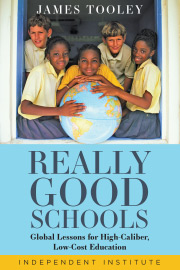Rags to Riches (to Rags Again)
“Most income statistics present a snapshot picture as of a given moment—and their results are radically different from those statistics which follow the same given individuals over a period of years.” —Thomas Sowell
Last week, CNNMoney carried a fascinating report on how rich families end up squandering their wealth:
Nearly 60% of the time a family’s money is exhausted by the children of the person who created the wealth, according to Roy Williams, president of wealth consultancy The Williams Group. In 90% of the cases it’s gone by the time the grandchildren die....
Perhaps the most famous example is the Vanderbilt family. Cornelius, the patriarch, built a fortune on railroads and shipping during the mid-1800s. Adjusted for the size of the economy, he was the second richest American ever, worth over $200 billion—well above Bill Gates.
Yet his children—and especially, his grandchildren—lived lavishly, building huge mansions in New York City, Newport, R.I., and elsewhere, and did little to preserve the fortune. By the 1970s, the family held a reunion with 120 members attending, and there wasn’t a millionaire among them, wrote Michael Klepper and Robert Gunther in their book The Wealthy 100.
Besides the tendency of the heirs to indulge and live lavishly, experts interviewed in this story stated that the main reason why family fortunes ended up evaporating is because the original wealth creators do not give clear instructions on how to handle the money after they’re gone. As a result, surviving family members often engage in bitter infighting, leading to an eventual loss of fortune.
This sober analysis is a refreshing reality check as we often hear popular class-warfare narratives of how the “rich are getting richer” at the expense of everyone else. The economist Thomas Sowell has addressed the rhetoric surrounding income and wealth inequality in many of his writings. In one column, he directly takes on “numbers games” and points out how statistics are often used out of context:
Currently we are hearing a lot in the media and in politics about the “top one percent” of income earners who are supposedly getting an ever-increasing share of the nation’s income.
That is absolutely true if you are talking about income brackets. It is totally untrue if you are talking about actual flesh and blood people.
The Internal Revenue Service can follow individual people over the years because they can identify individuals from their Social Security numbers. During recent years, when “the top one percent” as an income category has been getting a growing share of the nation’s income, IRS data show that actual flesh and blood people who were in the top one percent in 1996 had their incomes go down—repeat, DOWN—by a whopping 26 percent by 2005.
How can both sets of statistics be true at the same time? Because most people who are in the top one percent in a given year do not stay in that bracket over the years. [Emphasis added.]
If we are being serious—as distinguished from being political—then our concern should be with what is happening to actual flesh and blood human beings, not what is happening to abstract income brackets.
Sowell elaborates upon his arguments on wealth inequality in his excellent book Economic Facts and Fallacies. A whole chapter is devoted to “Income Facts and Fallacies.” Sowell cites many empirical studies, but the Forbes annual list of the top 400 richest people is particularly illustrative. When Forbes published its first rankings in 1982, people with inherited wealth composed 21 percent of that list. In other words, nearly 80 percent of these super rich people earned their money themselves. By 2006, it was reported that less than 2 percent of the people on the Forbes top 400 list were there because of inherited wealth.
A more recent study, “It’s the Market: The Broad-Based Rise in the Return to Top Talent,” by economists Steven N. Kaplan of the University of Chicago and Joshua Rauh of Stanford University corroborates these trends. The authors find that inherited wealth has a short half-life:
The inheritance of a small family business and the building of it into a larger business was never very common but represents a trivial fraction of the sample by 2011. Much of the increase in the first generation businesses has come at the expense of the second-generation and third-generation inherited businesses or wealth. The share of fourth, fifth, and sixth generation inherited businesses or wealth has virtually evaporated.
The fact remains that income mobility remains alive and well in America today. As Sowell reminds us, it is important to see what is going on with “actual flesh and blood human beings.” Politicians and grievance mongers may score political points using tirades against the “top one percent” or the “super rich”—but this kind of empty rhetoric means little when one takes the time to examine the actual facts over the long run. People with humble backgrounds can still ascend on the economic ladder, but getting rich is no guarantee of staying rich.


















